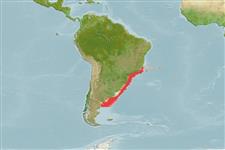Common names from other countries
Environment: milieu / climate zone / depth range / distribution range
বাস্তুসংস্থান
; গভীরতার পরিসীমা 30 - 300 m (Ref. 96968). Subtropical; 20°S - 44°S, 65°W - 28°W (Ref. 107072)
Southwest Atlantic: Brazil to Argentina.
Length at first maturity / আকৃতি / ওজন / Age
Maturity: Lm ? range ? - ? cm Max length : 9.0 cm ML পুরুষ/ লিঙ্গ অনিধর্ারিত ; (Ref. 105659); সর্বোচ্চ উলি্ল্লখিত বয়স : 2.00 বৎসর (Ref. 104514)
Frequently caught in bottom trawls together with Eledone gaucha Haimovici, 1988 (Ref. 104514). Benthic (Ref. 104514). Coexists with Eledone gaucha along the continental shelf and slope. Inhabits soft bottoms, on both sandy and muddy bottoms. Feeds mainly on crustaceans such as crabs and stomatopods (Ref. 104173).
Mating behavior: Males perform various displays to attract potential females for copulation. During copulation, male grasp the female and inserts the hectocotylus into the female's mantle cavity where fertilization usually occurs. Life cycle: Embryos hatch into planktonic stage and live for some time before they grow larger and take up a benthic existence as adults (Ref. 833). Eggs are attached on a hard substrate. Females die after releasing the hatchlings (Ref. 104514).
Roper, C.F.E., M.J. Sweeney and C.E. Nauen. 1984. (Ref. 275)
IUCN Red List Status (Ref. 130435)
CITES status (Ref. 108899)
Not Evaluated
Not Evaluated
Human uses
মৎস্য: বাণিজ্যিক
| FishSource |
হাতিয়ার
আরো তথ্য
Age/Sizeবৃদ্ধিLength-weightLength-lengthবহিঃ অঙ্গ সংস্থানশুককীট প্রাচুর্য
ইন্টারনেট সুত্র
Estimates based on models
Preferred temperature
(Ref.
115969): 7.7 - 21.7, mean 13.7 (based on 74 cells).
Vulnerability
Low vulnerability (10 of 100).
